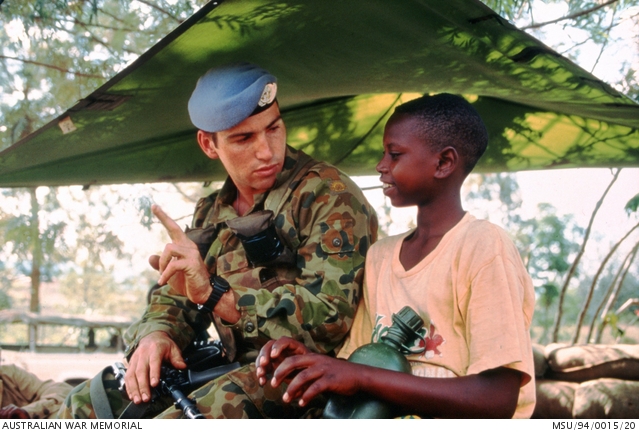30th anniversary of the first Australian troops to arrive in Rwanda
Private Trent Burnard, 2nd/4th Battalion, the Royal Australian Regiment, with a local boy in Kigali, September 1994. Photograph by Geoffrey Fox.
There was little that Australians could do to prepare themselves adequately for what they would encounter in Rwanda. In early 1994 the tiny East African country had been the site of one of the most concentrated genocides of the twentieth century. In the space of just three months, an estimated 800,000 men, women and children, mostly from the Tutsi ethnic group, were massacred by extremist Hutu militias. Machete was the most common weapon; churches provided no refuge; and former friends, neighbours, community leaders and school teachers took part in the violence.
Captain Ross Railton, an Australian Army physiotherapist, providing therapy to a landmine victim, December 1994. Photograph by Geoffrey Fox.
A UN peacekeeping force, the United Nations Assistance Mission for Rwanda (UNAMIR), was established in 1993 as tension escalated in the country, but the force did not have adequate resources to stem the increasing violence nor to stop the genocide. Australia did not participate in UNAMIR, but did contribute to the second iteration of the mission, dubbed UNAMIR II, an expansion on the original UN mission starting in May 1994. Australia’s contribution was Operation Tamar, in which some 656 ADF personnel served in two contingents to Rwanda between August 1994 and August 1995.
When the Advance Party of Australians began to arrive in Rwanda on 7 August 1994, the first main task was to prepare the military wing of the Kigali Central Hospital for use as a working health centre. This would become a main base of Australian operations for the next year. The hospital had been damaged in the civil war, and during the genocide it had become a shelter for hundreds of desperate refugees. The Advance Party found the hospital covered in months of accumulated filth; it had no power, water, or working sewerage system. The toilets, lacking running water, needed to be cleared of solidified excrement, and the gas masks worn by those tasked with their clearance did little to assist. The hospital morgue, which had no power and therefore no refrigeration, needed to be cleared of human remains.
In a little over a week, the hospital wing was nearly ready, and before long the main body of Australian medical staff and infantry began to arrive. Although they were in the country principally to provide health care to the 40 nation strong UN mission, the Australians used their spare capacity to assist the civilian population as well. The Australian medical staff found themselves treating a variety of cases that were unfamiliar to many in the medical profession in Australia: mine blasts, gunshot wounds, and rare diseases. By early 1995 it was estimated that the Australians were providing 50 per cent of Rwanda’s primary health care needs.
Hutu children at an Internally Displaced Persons (IDP) camp at Murambi. May 1995. Photograph by Justin Peter White.
Although the Australians had arrived in Rwanda after the civil war and genocide, the country was not completely free of violence. In Kigali, it was not uncommon for Australian medics to treat people suffering wounds from beatings, to hear gunshots during the night, or to find beaten and bound bodies left in rubbish dumps. Hutu militias continued deadly attacks on civilians, and the Australians assisted by treating the wounded in the aftermath. Similarly, the Tutsi-dominated Rwandan Patriotic Army carried out reprisal attacks on Hutus, including Hutu civilians returning home from camps across the countryside. The continued violence made the process of returning Rwanda to some sense of normality difficult. Australian troops providing security for the Australian medical team had frequent run-ins and stand-offs with the increasingly hostile Rwandan troops, many of whom resented the international presence in their country so soon after they had emerged victorious from the civil war.
Australian troops drawn from 5/7th Battalion, the Royal Australian Regiment, with an Australian armoured personnel carrier in Kigali, April 1995. Photograph by Justin Peter White.
In January 1995, Australians of the first contingent investigated a massacre at Busanze; and in April 1995, 32 Australians of the second contingent were present at the Internally Displaced Persons camp at Kibeho when Rwandan government troops opened fire on mostly Hutu civilians, killing an estimated 4,000 of them in a single day. The Kibeho Massacre has become a defining event for the Australian experience in Rwanda, and four Australians were awarded Medals for Gallantry for their efforts to protect and treat the wounded on that day; but it was only one of many traumatic events for the more than 600 Australians who served in Rwanda over the course of a year.
Corporal Mark Blake (left) and Private Dan Bennett (right) in the aftermath of the Kibeho Massacre, 26 April 1995. Photograph by Jeff Bowker.
Few who served in Rwandan came home unaffected by the scenes they had encountered and the hardships they had endured.




